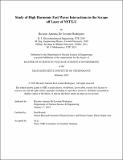Study of High Harmonic Fast Waves Interactions in the Scrape off Layer of NSTX-U
Author(s)
De Levante Rodriguez, Ricardo Antonio
DownloadThesis PDF (26.91Mb)
Advisor
Bonoli, Paul
Terms of use
Metadata
Show full item recordAbstract
High-harmonic fast wave (HHFW) heating experiments in the National Spherical Torus Experiment (NSTX) at Princeton Plasma Physics Laboratory (PPPL) have shown that up to 60% of the injected power can be lost in the Scrape-Off Layer (SOL) when the fast wave is able to propagate in front of the antenna [Hosea, Phys. Plasmas 15, 056104 (2008))]. This work discusses progress in modeling HHFW propagation and losses in the divertor region using more realistic SOL plasmas in the NSTX-U SOL 2D geometry. Previous RF studies assume density is a function only of magnetic flux, decaying exponentially, which may be insufficient to accurately determine the wavefield, especially in the divertor and high-field side plasma regions. In this work, the temperature profile is first evaluated by solving the non-linear heat conduction equation using a finite element approach in the Petra-M workbench assuming axisymmetry. A 2D density profile is then obtained from a prescribed outer midplane radial profile assuming pressure is uniform on a flux surface. This approach results in density and temperature profiles in which the strong asymmetric nature of diffusion is successfully captured. In particular, it is shown that for a parallel to perpendicular heat conduction anisotropy ratio of up to 10⁸ the expected exponentially decaying temperature profile is obtained using a non-linear iterative solver with proper mesh refinement conditions. Furthermore, this work focuses on investigating the effect of the SOL plasma density profile on the fast-wave propagation at different antenna phasing. The simulation results show that the gradient of the midplane density profile affects the wavefield pattern. As the density profile broadens, the wavefield intensity is reduced in the SOL and increased in the core. Finally, HHFW power in the plasma was studied by adding electron-ion collision power dissipation as a proxy for HHFW power deposition. The simulation results show that increasing the density gap width between the antenna and the core results in more power deposited in the SOL relative to the core.
Date issued
2025-02Department
Massachusetts Institute of Technology. Department of Nuclear Science and EngineeringPublisher
Massachusetts Institute of Technology